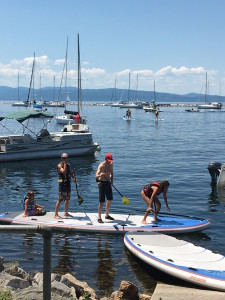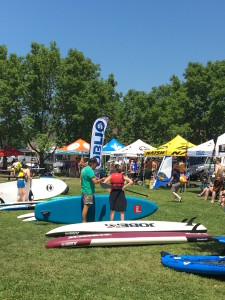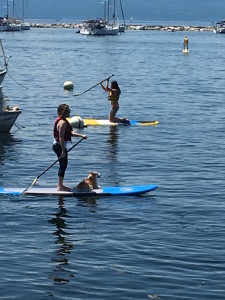Stand Up Paddleboard, or Stand Up Paddling, or simply SUP, may be here to stay. Skeptics dubbed the sport another passing fad, but that was sometime around 2001 or 2002. Here we are, more than a decade later, and we see boards strapped to car roofs, beached on shorelines, and, of course, on the water.
Here in Vermont, most SUP paddling is done on flat water, though Lake Champlain, power boats and even a windy day can give the paddler rock and roll. In other areas, SUP is more closely connected to its surfing roots from places such as Hawaii and with names such as Laird Hamilton.
Standing up to paddle can be traced back for centuries. Old paintings and a multitude of anecdotes suggest SUP possibly dates back far more than the early 20th century. Of course it’s probable that Native Americans stood in their canoes to paddle up river, but the claim that in Peru as long ago as 3,000 BC, and possibly even Pharoah’s daughter, the one who found baby Moses in the rushes, was standing up to paddle, necessitates unsubstantiated acceptance. (To read an intriguing and short history of SUP go to http://www.supthemag.com/complete-short-history-sup/)
Assuming you find the sport of SUP interesting and would like to give it a go, there are many ways in which to do so. By all means, rent a SUP or borrow a friend’s, and get on the water before you decide to purchase. However, remember that when you do, you may not be on the board that is most appropriate for you. It’s a good way to taste but not to digest. And, to be sure, a SUP lesson is a great way to begin.

SUP – a family adventure
photo by L. Freeman
Once hooked, you will want your own board, paddle, leash and pfd. (Note that a Type 3 USCG approved personal floatation device is mandated by law. If you are over 12 years old, you do not need to be wearing, but must have one easily accessible on the deck. Twelve and under must be wearing.)
HOW TO CHOOSE A BOARD
How do you choose your board? The best answer is to visit a water sports store where an informed associate can give you good advice, not just sell you a board. Finding the right board is not rocket science, but it really does matter and must meet your individual needs, fitness level, body type and budget. Buy the right board the first time and your purchase will be cost effective in the long run.
For more information I visited Umiak Outdoor Outfitters on South Main Street, Stowe (www.UMIAK.com) where Mike Strojny, assistant retail manager, spent unhurried time answering my many questions. Here’s what I learned.
What do you want to do with SUP? Is it for fun and fitness or touring or maybe even racing?
There are basically two types of hulls from which to choose: planing and displacement. A planing hull is flat and wide like a surfboard, costs a little less money to build and therefore a little less money to buy, and “is the board that most recreational customers come into the store looking for,” Strojny said.
“We think most people should buy a displacement board because Vermont lakes and ponds are flatwater.” And why is that? A displacement hull is straighter and faster. The front and back (bow and stern) are slightly pointed allowing the board to be moved forward with less effort. A displacement board is a good choice for the recreational paddler who wants the option to spend his or her hours and effort touring. Displacement boards are far more stable than one might think and versatile in their use be it fitness, cruising or even yoga.
SUPs are built from the inside out, whereas a kayak or canoe is built from the outside in. Foam inside is wrapped in a fiberglass sock. While there are many kinds of boards, and some are extremely attractive, Strojny suggestions caution. “They’re like a nice sports car; it’s what’s under the hood that counts.” The variables are the materials (a plastic board will weight 45-50 pounds while its carbon fiber equivalent only 20 pounds or less), board length, width, thickness and volume. A textured mat or surface on the top of the board provides stable footing.
Put in simplest terms, the bigger the person, the longer the board needed. Also to be taken into consideration is where you will paddle, the size of your car roof, where you will store the board when not in use (an inflatable SUP folds up into a wheeled suitcase), and perhaps how far you will need to walk to the beach. Width affects stability. A board 31-36” wide will be more stable; one 29 or 30” will be faster. Volume is a mathematical equation of length x width x thickness. The answer suggests the board’s ability to float with a certain amount of weight on it. All boards have a fin to help tracking. Paddling skill aids in keeping that straight line while wind factors present problems of their own. Roughly speaking a smaller person, woman or child, might shop for a 10-11’6” board while a larger or taller person might move up to a 12’6” board. Athletic ability and fitness definitely play a role as well.
What else do you need? In addition to your SUP and PFD, you need a paddle leash. “Four people drowned a few weekends ago,” Strojny said. “Not around here. Lake Tahoe and elsewhere. They didn’t have a PFD and they didn’t have a leash.” Strojny went on to explain that a SUP can also function as a large floatation device. It’s unlikely that you will hit your head when you pitch off of one. You are, after all, standing. Most likely you will land in the water and, with your board attached by a leash, can reel it in and clamber back on, or at least hold yourself up until help arrives. Wearing a PFD (there are some that can be worn unobtrusively around the waist), is, of course, the ultimate safe way to paddle.
Finally you need a paddle. Yes, you use only one and it is very long. A quick measure is to stand on land with the blade tip next to your feet. With one arm extended straight up towards the sky, the end of the handle should be at your hand. On the board in the water, you will hold the top end with one hand and partway down the shaft with the other. Some paddles are adjustable, others are custom. Less expensive paddles are heavier and can cause stress to joints, fatigue and just maybe take away from the joy of paddling. Small, narrow blades and light, stiff paddles made of fiberglass or carbon fiber allow for more dynamic paddling, a faster cadence if desired, and a less tiring experience that can make racing, yes, but even touring more enjoyable. Sometimes it takes surprisingly little effort to move forward, but equally significant is the core workout you will get.
Oh, and one more thing. You will need a roof rack on your car, usually the bars already there will do. Hoisting the board to the roof is as easy as your board is light. Simple straps usually get the job done.
SUP FESTIVAL

Burlington SUP Festival 2016, photo by L. Freeman
I met Roxanne Scully at the 2nd Annual Burlington Paddleboarding and Windsurfing Festival, June 25, 2016, on one of those perfect Vermont days: sunny, breezy, lots of people eager to participate, vendors happy to answer questions and hopefully make a sale, kids, dogs, and boats and more boats. Festive indeed.
Roxanne and her husband, Russ, began with The Spot, a “surf style restaurant” near the Burlington waterfront. Along came a new sport, paddleboarding. “My husband and I started this whole venture,” Roxanne said. “There was an article in the NY Times about Russ. After that he became the go-to person for paddle board.” The Scullys mixed business and pleasure. Russ became a rep for Starboard paddleboards and soon the couple started selling out of their restaurant. It was not long before they opened WND&WVS (say it quickly and you’ll get wind and waves, of course), a SUP, windsurf and other types of water sports store. (www.wndnwvs.com ). When asked about the popularity of SUPs, Roxanne said: “I think it’s just the beginning. There are so many different ways to use it from enjoying the sunset with your family or dog to racing. There’s a large spectrum of what you can do.”
Though the festival was for SUP and windsurfing, I saw only SUPs. And I saw many. Juxtaposed against the backdrop of sailboats and cruisers, boats of mixed size and use, some moored and some in action, were dozens of people of all ages on a huge variety of boards. Some were adept, some a bit anxious. Some boards were slim, some were large enough for a family, some short, some long, some hard and some inflatables.
I noticed a woman wearing a dress, but holding a paddle. When I asked her if she was having a good time she told me that she was down to three boards. She had tried the inflatable and was surprised by how hard it was, not rubbery at all. But she did find it a bit “bouncy” on the water. She then tried one that was more sleek and a better performer. Finally she tried one somewhere in the middle, a board that was stiff on the bottom but had a soft covering on top. She was still uncertain. But one thing was for sure, she was going to buy one of these boards and SUP on Lake Champlain.
As noted above, paddles are important. But let me introduce you to Steve Berson of Oblio Paddles. (www.obliopaddles.com) When Berson first explored the world of SUP he loved standing on the board, but was uncomfortable with the concept of a single paddle with a single blade that had to be switched from side to side and sometimes caused balance and/or tracking problems by its very nature. Why not design a long paddle with a blade on each end with a rotating grip that would serve as an aid to balance (much like the tightrope walker and his pole) and would provide rhythm and symmetry to smooth the rough edges of an otherwise seamless sport? So he did. The process began in March 2014 in Morrisville. The first year was spent in development and prototyping. Today there are different models available ranging in price from $229-$429 and made of fiberglass, a composite, or top of the line carbon fiber.

Even this Welsh Corgi enjoys SUP on the Lake. photo by L. Freeman
Over the years we’ve learned that stand up paddleboarding is not limited to the big surf of Hawaii or southern California; or, in the State of Vermont, to larger lakes like Champlain or Bomoseen; or even Vermont’s smaller lakes and ponds, surrounded by summer camps and home to both motorized and non-motorized water craft. In fact, one may not really know just how much this sport may grow. SUP is one new kid on the block who may have moved in to stay. Perhaps this IS just the beginning. Perhaps in years to come we will see many variations on the SUP theme.
This story first appeared in the Rutland Herald & Times Argus Sunday newspaper, 7-3-2016 written by Linda Freeman, Field Editor and Contributor to Active Vermont.
